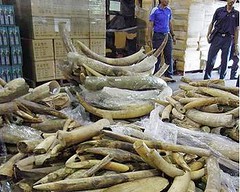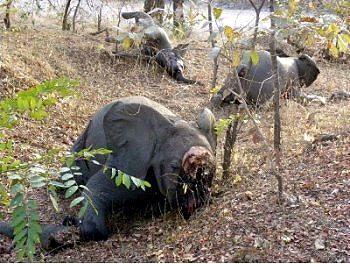喀麥隆北部Bouba Ndjida國家公園內,日前450頭大象遭盜獵者殺害。華盛頓公約(CITES)秘書長斯坎倫(John Scanlon)2月27日表達「極度關切」。他表示,CITES的監控計畫發現,2011年大象遭受盜獵的問題有增加的趨勢。
他說,該地區各國政府已提供資源找出肇事者並繩之以法,同時也找出並沒收被盜獵的象牙。他呼籲象牙貿易管道中潛在的過境與輸入國,要「採取合作並保持高度警戒」
Bouba Ndjida國家公園位於喀麥隆北部靠近查德共和國的邊界,2月20日發生槍響,盜獵者為取得象牙殺害大象,2天後尋獲遭棄屍的14頭大象。
 國際動物福利基金會(IFAW)大象計畫主任Jason Bell表示,在喀麥隆發現200多頭大象死亡後的不到一星期內,又發現了大象死亡事件,而接下來數周將可能發現更多死亡案例,因為槍響聲未曾間斷。
國際動物福利基金會(IFAW)大象計畫主任Jason Bell表示,在喀麥隆發現200多頭大象死亡後的不到一星期內,又發現了大象死亡事件,而接下來數周將可能發現更多死亡案例,因為槍響聲未曾間斷。
他警告說,該區域仍十分危險,不適合對屠殺事件進行調查,也不適合營救孤立四處漫遊的小象以及受傷的成象。
Bell認為,由查德南下至喀麥隆的蘇丹盜獵者,是最有可能的連續犯。過去幾年間,查德境內的大象族群數量由幾千隻驟減至剩下幾百隻,使盜獵者不斷的前進。
「遭盜獵者殺害的大象,死前承受了極大的恐懼與痛苦」,Bell 解釋,「許多職業的盜獵者,部分是現役或退役士兵,使用AK-47等制式武器。而AK-47原本只是設計用來殺死70至80公斤的人類,為了殺死近5000公斤的大象,必須耗掉掉非常多的彈藥,而動物的死亡過程則十分緩慢。」
大象目前分佈的地區在沙哈拉南部非洲的38個國家,雖然70%的非洲象棲地可能未受保育,多數大型的象群分布在像是喀麥隆 Bouba Ndjida 國家公園這類的保護區內。
自2004年起,普通非洲象(Loxodonta africana)在IUCN紅皮書中的保育等級,從原本的瀕危(EN)改善為易危(VU),這是基於1996年起IUCN SSC(世界自然保育聯盟物種存續委員會)非洲象專家小組的評估計畫。保育團體將這個結果歸功於CITES從1989年起實施的非洲象暨其產製品之國際貿易禁令。
 但IFAW以及其他保育團體則指責,CITES 於2008年簽准的中國與日本「一次性」象牙貿易引發了現在這波的大象盜獵潮。當時共有108噸的象牙由波茲瓦納、南非、奈米比亞以及辛巴威售出。
但IFAW以及其他保育團體則指責,CITES 於2008年簽准的中國與日本「一次性」象牙貿易引發了現在這波的大象盜獵潮。當時共有108噸的象牙由波茲瓦納、南非、奈米比亞以及辛巴威售出。
保育人士主張說,合法的象牙貿易增加了需求,並且掩護了非法的販運,結果造成了2009年查獲的走私象牙數量激增。
Scanlon 已指派 CITES 執法部的 Ben Janse Van Rensburg 為反應大象盜獵事件的協調特派員。
Van Rensburg 已與相關的國家以及國際打擊野生動物犯罪組織-國際刑警組織、世界海關組織、聯合國打擊毒品與罪犯辦公室以及世界銀行-合作,分享能將肇事者繩之以法、找出並沒收盜獵的象牙並預防未來盜獵事件的相關知識。
Scanlon 表示,CITES 有關當局無法確認所沒收的象牙來源,除了少數能夠進行DNA鑑定分析之外。所以建立國家、區域與國際的大象保育與管理手段是必要的。
他說,近來發生的大量屠殺事件,顯示了在 CITES 主導下建立有效實行象牙貿易控制行動計劃的必要性。
John Scanlon, secretary-general of the Convention on International Trade in Endangered Species, CITES, Tuesday expressed "grave concern" over the recent poaching of close to 450 elephants in Bouba Ndjida National Park in northern Cameroon.
He said the CITES program for monitoring the illegal killing of elephants shows increased levels of poaching in 2011.
He said governments of the region are being offered support to find and bring to justice those responsible and to locate and seize the poached ivory. He is urging potential transit and final destination countries to "remain extremely vigilant and to cooperate."
Fourteen dead elephants were found in Bouba Ndjida National Park, Cameroon last week, slaughtered by poachers for their tusks, which were cut out of the carcasses. Shots were heard on February 20 in the Bouba Ndjida National Park in northern Cameroon, near the border with Chad. The 14 elephant carcasses were discovered two days later.
The latest dead elephants were found just a week after the discovery of at least 200 dead elephants in Cameroon, and more will be found in the coming weeks as gunshots continue to be heard, said Jason Bell, director of International Fund for Animal Welfare's Elephant Programme.
He warns that the area "is still too dangerous to allow a survey of the massacre or rescue of the roaming orphaned elephant calves and wounded adults."
Bell believes that Sudanese poachers who travel south through Chad on their way to Cameroon are likely responsible for the continuing slaughter of elephants. In the past few years, Chad's elephant population has plunged from several thousand to a few hundred, forcing the poachers further afield.
"Elephants killed by poachers experience tremendous fear and suffering before dying," Bell explained. "Often professional poachers - some of whom are former or current soldiers - are armed with military weapons such as AK47s. The AK-47 is designed to kill a person who weighs 70 to 80 kilograms. In order to kill an elephant weighing 5,000 kgs you have to use a lot of bullets and it can take a very long time for the animals to die."
Elephants currently inhabit parts of 38 countries in sub-Saharan Africa. Although up to 70 percent of the African elephant's range is believed to lie in unprotected land, most large populations occur within protected areas such as Cameroon's Bouba Ndjida National Park.
Since 2004, the species, Loxodonta africana, has been classed as Vulnerable to extinction by the IUCN Red List of Threatened Species.
Their conservation status has improved since African elephants were listed as Endangered based on an assessment conducted in 1996 by the IUCN SSC African Elephant Specialist Group.
Conservation groups credit the upgraded listing to a CITES ban on international trade in African elephants and their parts that took effect in 1989.
IFAW and many other conservation groups blame the recent upsurge in elephant poaching on a legal "one-off" sale of ivory from African stockpiles to China and Japan allowed in 2008 by the Convention on International Trade in Endangered Species, CITES. A total of 108 tonnes of ivory from Botswana, South Africa, Namibia and Zimbabwe were sold.
Conservationists maintain that legal ivory sale increased demand and provided cover for illegal ivory trafficking. The result was a spike in ivory seizures in 2009.
Scanlon has designated Ben Janse Van Rensburg, CITES Chief Enforcement Support, as the point person for coordinating support for response to elephant poaching incidents.
Van Rensburg is engaging with the countries concerned as well as with partners in the International Consortium on Combating Wildlife Crime - Interpol, the World Customs Organization, the United Nations Office on Drugs and Crime and the World Bank - to share intelligence that could be used to help bring the perpetrators to justice, to locate and confiscate the poached ivory, and to help prevent future incidents.
Scanlon says CITES authorities have not been able to identify the actual origin of the seized ivory, except for a few cases where it was possible to make DNA profiling analysis. Therefore, a national, regional and international approach to manage and conserve elephants is essential.
This most recent mass killing demonstrates the need for effectively implementing the Action Plan for the control of trade in elephant ivory that was created under the auspices of CITES, he said.



